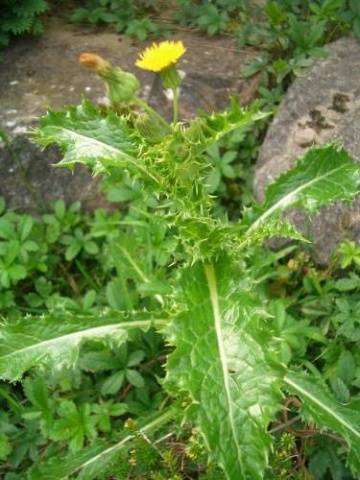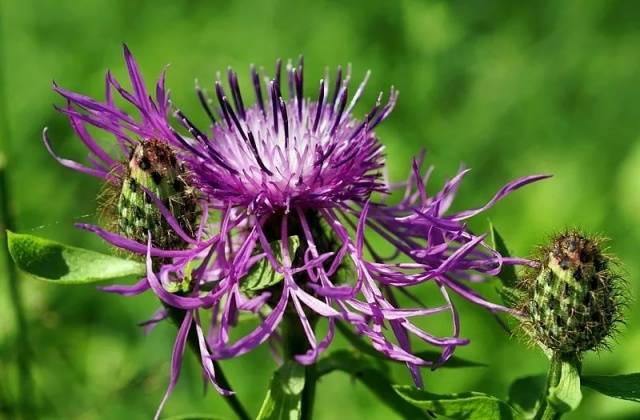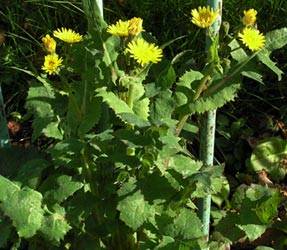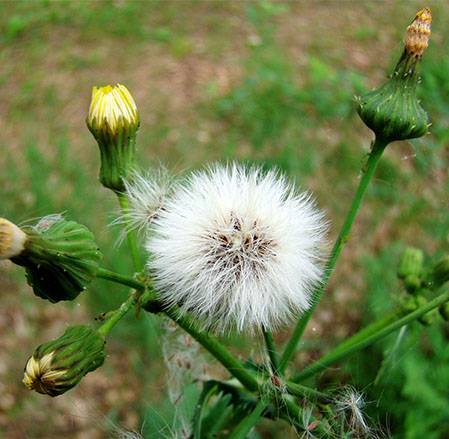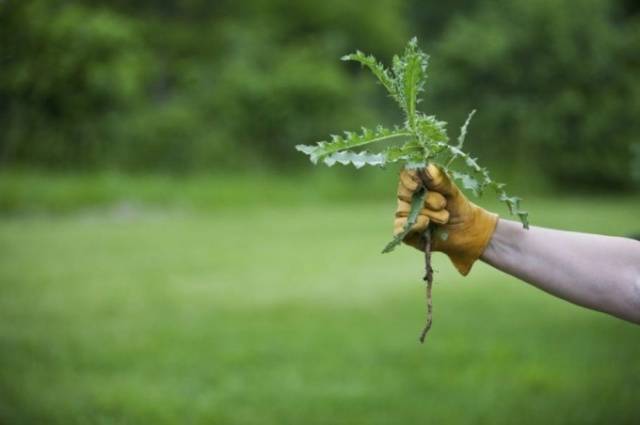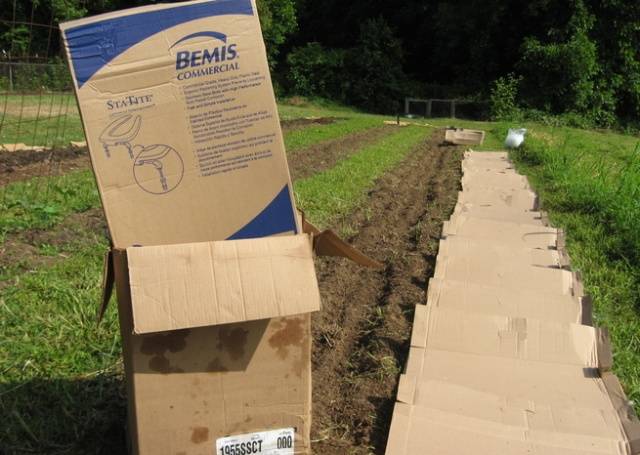Content
Weedsgrowing in suburban and personal plots, cause a lot of trouble for gardeners and gardeners. You have to spend a lot of time removing them, but they reappear. It is especially difficult to get rid of weeds with a powerful root system. They safely survive frost and drought, unlike cultivated plants.
One of the most annoying and difficult to remove is the sow thistle. What needs to be done to rid the earth of a harmful plant, in what ways to achieve its destruction. All these questions concern not only beginners, but also experienced gardeners.
Views
There are several types of asot in nature. They are mainly perennials (except for garden):
- field;
- garden;
- pink (rough).
In the photo there is a flowering sow thistle.
In this photo, the thistle is pink.
According to gardeners, these are the most tenacious weeds, so getting rid of them is not so easy.
Botanical properties
Sow thistle is a grass, annual, 50-120 cm high. But in one season, it develops a powerful root system, the central root goes deep. Pulling out the sow thistle is quite difficult due to the fragility of the root. Even from a small piece of root, a new plant soon appears. Sow thistle has a straight, smooth stem, hollow inside. At the fracture of the stem, you can see the milky juice that stands out.
Hard leaves are arranged alternately. Compared to pink thistle and wild thistle, they are not so prickly.
The leaves are pinnately dissected or pinnately lobed. You can recognize a thistle by the light yellow flowers collected in a basket. They are quite large, 35 cm in diameter. Flowering begins in early summer and continues until frost. Sometimes sow thistle flowers are confused with dandelion flowers.
In place of the bud, a fruit with seeds is formed, resembling a crest. The first seeds ripen in early July.
This tenacious weed grows not only in the garden, but also in the country and in the garden. Favorite places:
- vacant lots;
- abandoned and uncultivated fields for a number of years;
- valleys of rivers and lakes.
The plant likes fertilized soils, but does not neglect slightly saline and dry areas. The weed adapts to any conditions.
Good or harmful sow thistle on the site
Why is sow thistle dangerous in the garden
Seeing sow thistles on the plot, gardeners and truck farmers begin to come up with ways to destroy it. Tall plants with powerful roots harm the cultivated plantings in the garden:
- First, the sow thistle grows very quickly, if it is not destroyed in a timely manner, it will take up a large area of the garden or vegetable garden.
- Secondly, a fast growing sow thistle needs a lot of water and nutrients. The weed will simply draw out all the juices from the ground, which will leave the garden plantings without food. You don't have to wait for the harvest.
- Thirdly, the sow thistle, if not removed, manages to "scatter" the seeds on the site.
What is the use
Sow thistle is a useful plant, which not everyone knows about. The medicinal properties of the plant have not yet been studied perfectly, but there are many useful substances in sow thistle:
- vitamin C;
- carotene;
- fatty oils;
- alkaloids;
- inulin;
- choline;
- tartaric acid;
- bitterness.
The benefits of sow thistle:
- The inhabitants of the countryside feed the weed plant to the animals.
- The proximity of sow thistle with cultivated plants saves the garden from aphids.
- Using weeds as mulch enriches the soil with minerals.
- Young leaves of the plant are an excellent ingredient for making tea, salads, cabbage soup. The roots of the plant are also boiled, they are not inferior in value to Jerusalem artichoke.
- The medicinal properties of the weed have been known for a long time. Medicinal decoctions and infusions can be prepared from all parts of the plant, since they have medicinal properties.
- If the thistle has grown in a strawberry garden, the berries will be fragrant and sweet.
Beneficial features:
But despite the benefits, it is not necessary to propagate the weed in the garden. How to get rid of sow thistle in the garden is not an idle question.
Control methods
How to destroy a sow thistle in your plot? You can use different methods:
- mechanical;
- chemical;
- folk remedies.
Many gardeners believe that by getting rid of the grown plants in their garden, you can forget about the weed forever. But this opinion is incorrect, since the garden weed reproduces by seeds, and they can always be carried by the wind from a neighboring site or from the field.
Mechanical destruction
When a sow thist appears on your site, you need to take measures to destroy it.
It is best to chop up the weed and use it as mulch (green manure) or send it to the compost heap.
Many novice gardeners are interested in how to get a sow thistle out of the garden?
Let's try to understand this issue:
- You need to start when the plants are still small. It still has a weak root and is easy to pull out. Weeding garden weed should be done regularly.
- You cannot cut the plant with a shovel. If the gardener removed the aboveground part, and crushed the root into particles and left it in the ground, then the sow thistle will begin to grow with renewed vigor.
- Trying to root out the weed is not worth it, because the underground part remains. It is best to use a flat cutter for the job to trim the plant below the ground. From above, the soil can be mulched or covered with a film, a piece of roofing material. This is if nothing grows on the site.
- After harvesting, the soil is dug to a great depth and the roots of the sow thistle are removed.
Let's remove both the tops and the roots:
Traditional methods
The fight against sow thistle in the garden can be carried out not only by mechanical methods, but also by folk methods. Folk methods are more gentle. There are many options, but such folk remedies are used most often.
- Spraying with kerosene. The plant is cut off, and the root is poured with kerosene. This work can be carried out on an area where there are no cultivated plants.
- If you have flowers, Funny guys, you can plant them around the ridges. The weed will never live next to them.
- How to deal with sow thistle with plants? On a too clogged area, green manures are planted. When they grow up, they need to be covered and left until next spring. Over the summer, all weeds will die, at the same time the soil will be enriched with nutrients from the rotted grass.
- There is another effective folk remedy: trample the weeds and cover them with cardboard, roofing felt, garbage. There will be nothing left of the weeds.
Chemical attack
It often happens that a piece of land was purchased that previously belonged to careless owners. Neither mechanical methods nor folk remedies are helpers here. We get rid of weeds with chemicals.
Today you can buy a variety of products, including herbicides:
- Tornado;
- Hurricane.
You can use the drugs on areas left under steam or on paths. Crop plants must be covered during processing, otherwise they will burn.
Conclusion
Despite the benefits of sow thistle, its medicinal and medicinal properties, it should not be left in the garden. Fight him in every possible way. After all, one plant produces many brown seeds with fluffy tufts. They are able to scatter a great distance from the mother bush.
In the fall, after digging the ridges and removing the sow thistle root, do not loosen the soil. Let the seeds sit on the surface. They do not tolerate low temperatures and die. Keep the site clean, then the harvest will delight.

